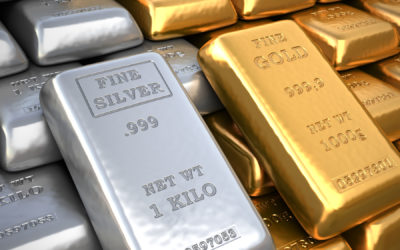Precious metals are part of every investor’s portfolio, and Petr Saic recently gave us a lecture about them. We talked mainly about investing in gold and silver and it got a great response. That’s why we decided to compile the whole topic into a clear article. Do you know when and in what form of gold and silver to invest?
Interest rates are a check on the economy
When the economy is doing well, interest rates rise. Not so today. Denmark, for example, currently has minus rates on mortgages and our neighbouring countries are not much better off. This, of course, lowers interest rates here, even though our economy is doing well. The fall in rates is also linked to the greater indebtedness of countries that are well suited to low interest rates. They would hardly be able to repay higher rates. It is therefore to be expected that interest rates will not continue to rise. Because of this, the market will continue to run out of money and its value will fall. This favours investment in commodities, especially silver and gold, the price of which is relatively stable.
How do buying gold bullion, coins and medals differ?
There is a big difference between buying gold bullion, investment or commemorative coins and medals. In the case of gold bullion and investment gold, the production premium is very low and the purchase price is therefore almost identical to the exchange price of the metal. Buying them, therefore, does not make you a collector but an investor in gold. However, this is not the case for commemorative coins or medals. The production premium is higher and the future rarity of the object is more important than the price of the metal. Not familiar with numismatics and not a collector? Then avoid these purchases or buy coins of new issues where the price of the coin is close to the price of the metal. There is also a difference in the payment of VAT, while gold bullion, investment and commemorative coins are exempt from VAT, this does not apply to medals.
The secret of liquidity of precious metal objects
There is also a big difference in liquidity between gold bullion, investment and commemorative coins and medals. Gold bullion and investment coins are essentially just a piece of metal, so selling them is usually not a problem. This is not the case with commemorative coins and medals. Their marketability is based on the rarity of the item. If you are not familiar with numismatics, buying them is more of a lottery bet.
“Branded gold” has an undeniable advantage
Although the liquidity of gold coils and investment coins is high, we still recommend buying only “branded gold” from large foundries. With such purchases, there is usually a buyback guarantee and a guarantee that the manufacturer or seller will not go out of business overnight. Selling elsewhere is possible, but at a slight disadvantage. Each product should then have a certificate of authenticity, QR code of the refinery, veriscan, etc. You can tell by these marks that the refinery really does register it.
In the case of investment coins, the situation is similar. It is advisable to buy only globally known ones and ignore regional ones that don’t sell so well in other countries. Some of the most famous coins include the Austrian Wiener Philharmoniker, the American Eagle, the Canadian Maple Leaf, the South African Krugerrand, the British Britannia and the Chinese Panda. Europe sells mainly the Wiener Philharmoniker, America the American Eagle and China the Panda.
The quantity of purchases is important
The purchase price varies according to the weight of the precious metal. An example from recent history: while 1 gram of gold cost CZK 1,600, buying 10 grams cost only CZK 1,200 and buying one ounce, i.e. about 31 grams, will set you back only CZK 1,126 per gram. We therefore recommend that you always buy at least 10 grams of gold when investing in gold. It is therefore no coincidence that the most traded coins weighing one ounce are those priced at 35 – 40 thousand. These coins account for almost 90% of the trade. Larger weights, on the other hand, are harder to sell. The reason is simple, e.g. a kilo of gold costs about 1.2 million crowns and it is harder to find a buyer.
Buy gold or silver?
Although the price of silver and other precious metals is usually derived from the price of gold, today’s situation is slightly different. The price of silver is undervalued compared to gold. The ratio between gold and silver has long stood at 1:20, but is now at 1:85. So for a kilo of gold you get 85 kg of silver. If you want to invest in a metal today, silver is a good choice.
Make money selling, not buying
As mentioned earlier, it is not worth buying uncertified gold and silver. It’s a huge risk, no matter how low the price. However, it is definitely worth making a profit on a bargain sale. When is it? The price of a bargain sale certainly can’t be pinpointed, but the timing can. Sell in a crisis when everyone else is buying. The price of precious metals will be higher then. It is definitely not recommended to sell at once then, but continuously. It does not pay to wait for a peak. Those who wait for it may not get it. Selling continuously will ensure a more balanced profit.
Other types of gold investment
Besides buying bullion and coins, there is another form of investment in gold and silver. You can also invest in instruments that are linked to the price of gold. These include ETFs, futures or CFD contracts. However, physical gold is physical gold. Shares in companies whose business is related to gold (e.g. mining companies) may also be of interest.
Are you also considering investing in gold and silver but still don’t know what to do? Feel free to contact us, we can answer your questions or explain the topic further or recommend proven partners for your purchase.

